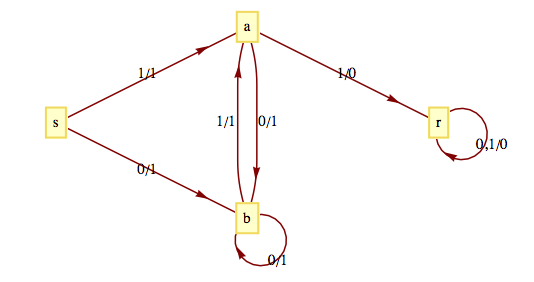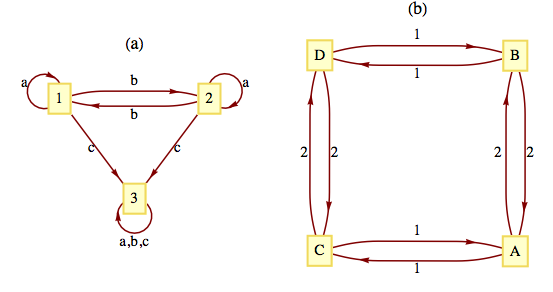The transition diagram for the machine that recognizes strings in \(B*\) that have no consecutive 1’s appears in Figure 14.4.2. Note how it is similar to the graph in Figure 9.1.4. Only a “reject state” has been added, for the case when an input of 1 occurs while in State \(a\text{.}\) We construct a similar table to the one in the previous example to study the effect of certain strings on this machine. This time, we must include strings of length 3 before we recognize that no “new effects” can be found.

No Consecutive Ones Monoid
\(\begin{array}{ccccccccccccccc}
\textrm{ Inputs} & 0 & 1 & 00 & 01 & 10 & 11 & 000 & 001 & 010 & 011 & 100 & 101 & 110 & 111 \\
s & b & a & b & a & b & r & b & a & b & r & b & a & r & r \\
a & b & r & b & a & r & r & b & a & b & r & r & r & r & r \\
b & b & a & b & a & b & r & b & a & b & r & b & a & r & r \\
r & r & r & r & r & r & r & r & r & r & r & r & r & r & r \\
\textrm{ Same} \textrm{ as} & & & 0 & & & & 0 & 01 & 0 & 11 & 10 & 1 & 11 & 11 \\
\end{array}\)
The following table summarizes how combinations of the strings \(0,1,01,10, \textrm{ and } 11\) affect this machine.
\begin{equation*}
\begin{array}{c|c}
* &
\begin{array}{ccccc}
T_0 & T_1 & T_{01} & T_{10} & T_{11} \\
\end{array}
\\
\hline
\begin{array}{c}
T_0 \\
T_1 \\
T_{01} \\
T_{10} \\
T_{11} \\
\end{array}
&
\begin{array}{ccccc}
T_0 & T_1 & T_{01} & T_{10} & T_{11} \\
T_{10} & T_{11} & T_1 & T_{11} & T_{11} \\
T_0 & T_{11} & T_{01} & T_{11} & T_{11} \\
T_{10} & T_1 & T_1 & T_{10} & T_{11} \\
T_{11} & T_{11} & T_{11} & T_{11} & T_{11} \\
\end{array}
\\
\end{array}
\end{equation*}
All the results in this table can be obtained using the previous table. For example,
\begin{equation*}
\begin{array}{c}
T_{10}*T_{01}=T_{1001}=T_{100}*T_1=T_{10}*T_1=T_{101}=T_1\\
\textrm{ and} \\
T_{01}*T_{01}=T_{0101}=T_{010}T_1=T_0T_1=T_{01}\\
\end{array}
\end{equation*}
Note that none of the elements that we have listed in this table serves as the identity for our operation. This problem can always be remedied by including the function that corresponds to the input of the null string, \(T_{\lambda }\text{.}\) Since the null string is the identity for concatenation of strings, \(T_sT_{\lambda }=T_{\lambda }T_s=T_s\) for all input strings \(s\text{.}\)



